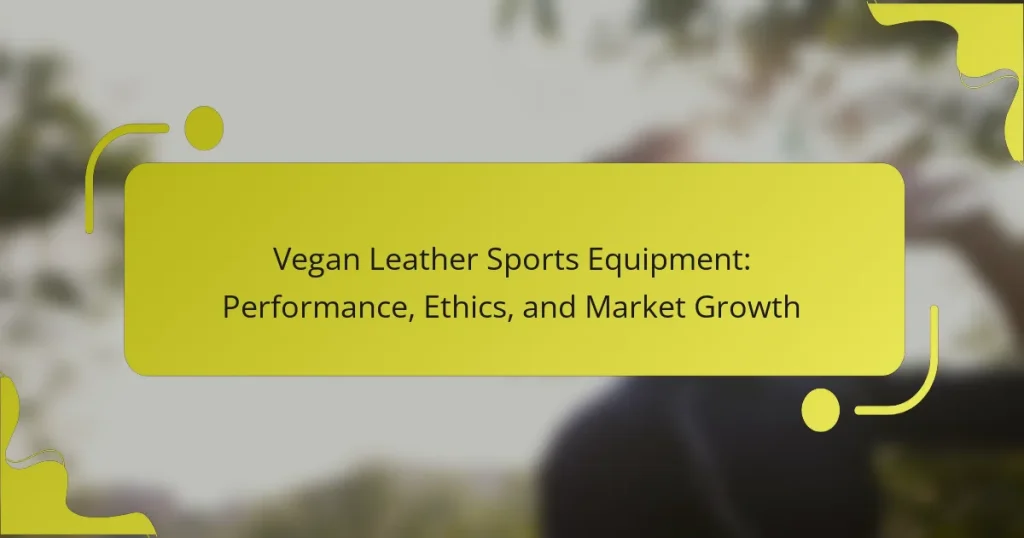Vegan leather sports equipment offers high performance while addressing ethical and environmental concerns. This article explores its durability and flexibility, the ethical advantages of avoiding animal products, and the significant market growth projected to reach $89 billion by 2025. Leading brands like Adidas and Nike are adopting these sustainable materials, reflecting a shift towards eco-friendly sports gear.
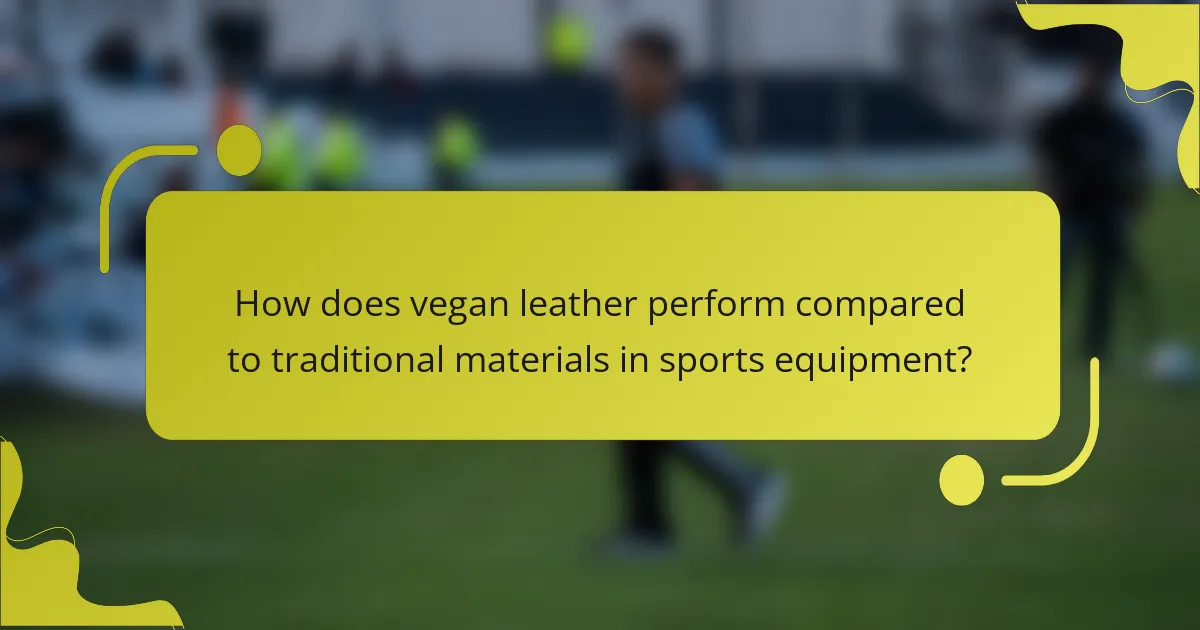
How does vegan leather perform compared to traditional materials in sports equipment?
Vegan leather generally performs well in sports equipment, often matching or exceeding traditional materials in durability and flexibility. Its lightweight nature contributes to improved performance metrics.
Vegan leather is resistant to water and stains, making it suitable for various sports environments. Additionally, it offers ethical advantages by avoiding animal products. Market growth for vegan leather in sports equipment reflects increasing consumer preference for sustainable options.
Comparative performance metrics highlight that vegan leather can be as durable as traditional leather, with some studies showing equal or better abrasion resistance. The environmental impact of vegan leather is typically lower, appealing to eco-conscious athletes.
| Attribute | Vegan Leather | Traditional Leather |
|———————–|———————-|————————|
| Durability | High | High |
| Weight | Lightweight | Heavier |
| Water Resistance | Excellent | Moderate |
| Environmental Impact | Lower | Higher |
| Flexibility | Comparable | Comparable |
| Ethical Consideration | High | Low |
What are the key performance metrics for vegan leather sports gear?
Key performance metrics for vegan leather sports gear include durability, moisture resistance, weight, breathability, and environmental impact. These factors determine the overall effectiveness and appeal of the gear.
| Metric | Value |
|———————–|————————–|
| Durability | Comparable to traditional leather |
| Moisture Resistance | High |
| Weight | Lightweight |
| Breathability | Enhanced |
| Environmental Impact | Lower carbon footprint |
How does durability of vegan leather impact its use in sports?
The durability of vegan leather significantly enhances its use in sports equipment. High durability ensures that products withstand rigorous activities, maintaining performance while being environmentally friendly. Vegan leather often features resistance to wear and tear, making it suitable for various sports applications. For example, vegan leather soccer balls exhibit longevity comparable to traditional leather, promoting sustainability without sacrificing quality.
Which sports benefit most from vegan leather equipment?
Vegan leather equipment benefits sports like tennis, soccer, and cycling most due to their high-performance requirements and ethical consumer demand. Tennis players appreciate vegan leather for its durability and grip, enhancing playability. Soccer gear made from vegan leather offers excellent ball control and weather resistance, appealing to eco-conscious players. Cyclists benefit from lightweight, breathable vegan leather, improving comfort during long rides. The market for vegan leather in sports is growing, driven by sustainability trends and increased awareness of animal welfare.
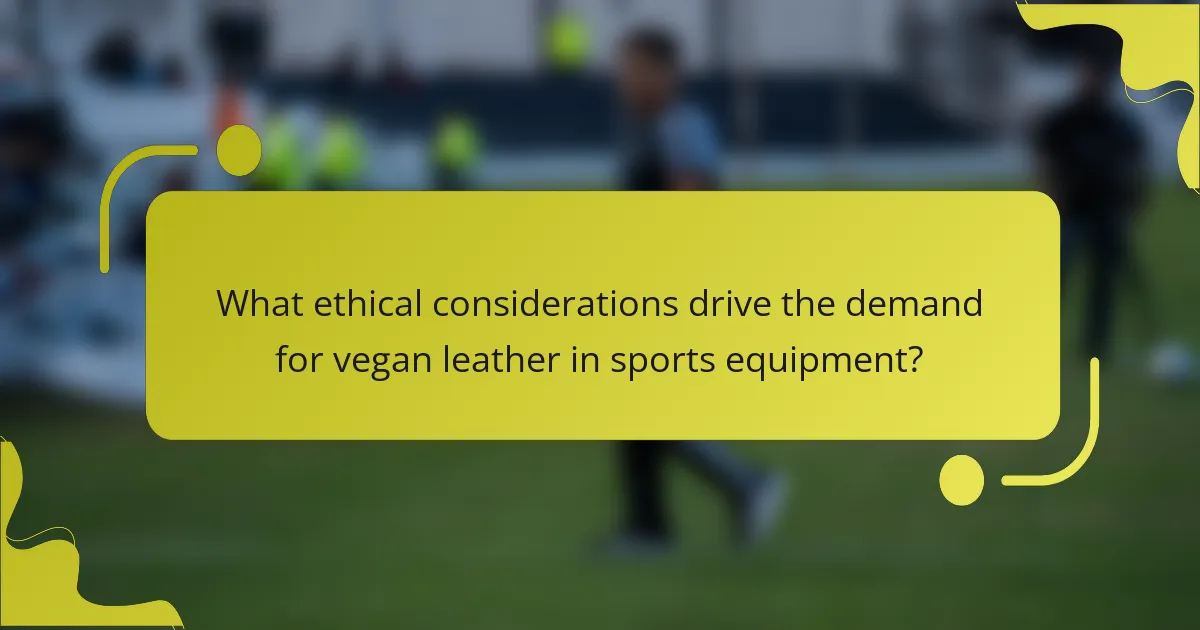
What ethical considerations drive the demand for vegan leather in sports equipment?
The demand for vegan leather in sports equipment is driven by ethical considerations surrounding animal welfare and environmental sustainability. Consumers increasingly prefer alternatives that do not involve animal cruelty and reduce carbon footprints.
Vegan leather aligns with the growing awareness of environmental impact. Traditional leather production often involves significant water use and pollution. In contrast, many vegan leather options utilize recycled materials or plant-based sources, appealing to eco-conscious consumers.
Market growth reflects these ethical trends. A study indicated that the global vegan leather market is expected to reach $89 billion by 2025, driven by consumer demand for sustainable and cruelty-free options. Brands adopting vegan leather enhance their ethical stance, attracting a broader audience.
As a result, ethical considerations significantly influence the shift toward vegan leather in sports equipment, promoting both performance and sustainability.
How does vegan leather align with sustainable practices in the sports industry?
Vegan leather aligns with sustainable practices in the sports industry by reducing reliance on animal products and minimizing environmental impact. It offers a cruelty-free alternative, appealing to ethically conscious consumers. Production methods often utilize recycled materials, lowering carbon footprints. As a result, vegan leather supports the growing demand for eco-friendly sports equipment. This shift reflects a broader market trend towards sustainability in athletic gear.
What are the environmental impacts of producing vegan leather compared to animal leather?
Producing vegan leather generally has a lower environmental impact than animal leather. Vegan leather often uses synthetic materials, which can reduce land use and methane emissions associated with livestock farming.
However, the production of synthetic vegan leather can involve fossil fuels and chemicals, raising concerns about pollution and resource consumption. In contrast, animal leather production contributes to deforestation and significant greenhouse gas emissions.
Vegan leather options, such as those made from pineapple leaves or apple peels, offer sustainable alternatives with lower ecological footprints. As the market for vegan leather sports equipment grows, innovations continue to improve its sustainability and performance.
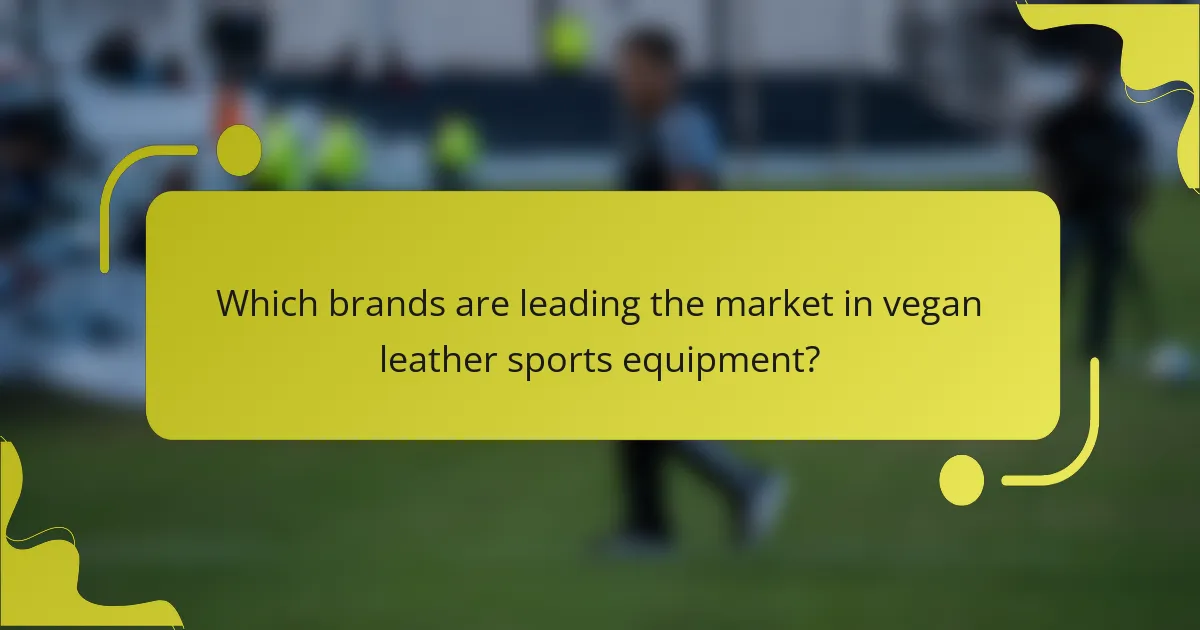
Which brands are leading the market in vegan leather sports equipment?
Leading brands in vegan leather sports equipment include Adidas, Nike, PUMA, and Reebok. These companies prioritize sustainable materials and ethical production practices. Adidas, for example, uses a synthetic leather alternative made from recycled plastics. Nike’s Move to Zero initiative focuses on reducing environmental impact through innovative materials. PUMA has introduced its own line of vegan products, emphasizing animal welfare. Reebok’s partnership with vegan leather suppliers showcases its commitment to sustainable sports gear. These brands reflect a growing market trend towards eco-friendly sports equipment.
What unique features do top brands offer in their vegan leather products?
Top brands in vegan leather sports equipment offer unique features like durability, eco-friendliness, and innovative designs. They prioritize performance with materials that mimic traditional leather while being lightweight and water-resistant. Ethical sourcing practices enhance brand appeal, attracting environmentally conscious consumers. Advanced production techniques lead to superior texture and aesthetics, setting these products apart in the market.
How do consumer preferences vary across different regions for vegan sports gear?
Consumer preferences for vegan sports gear vary significantly by region due to cultural, economic, and environmental factors. In North America, there is a strong emphasis on performance and sustainability, with consumers favoring high-quality vegan leather that offers durability and functionality. In contrast, European markets prioritize ethical considerations, often seeking products that align with broader environmental values.
In Asia, the growing middle class is increasingly interested in both performance and style, leading to a rise in demand for fashionable vegan sports gear. Additionally, regions with strong agricultural ties may exhibit unique preferences for locally sourced materials.
Market growth for vegan leather sports equipment is robust globally, driven by a shift towards ethical consumerism and increased awareness of animal welfare. As a result, brands are adapting their offerings to meet diverse regional preferences, ultimately shaping the future of the market.
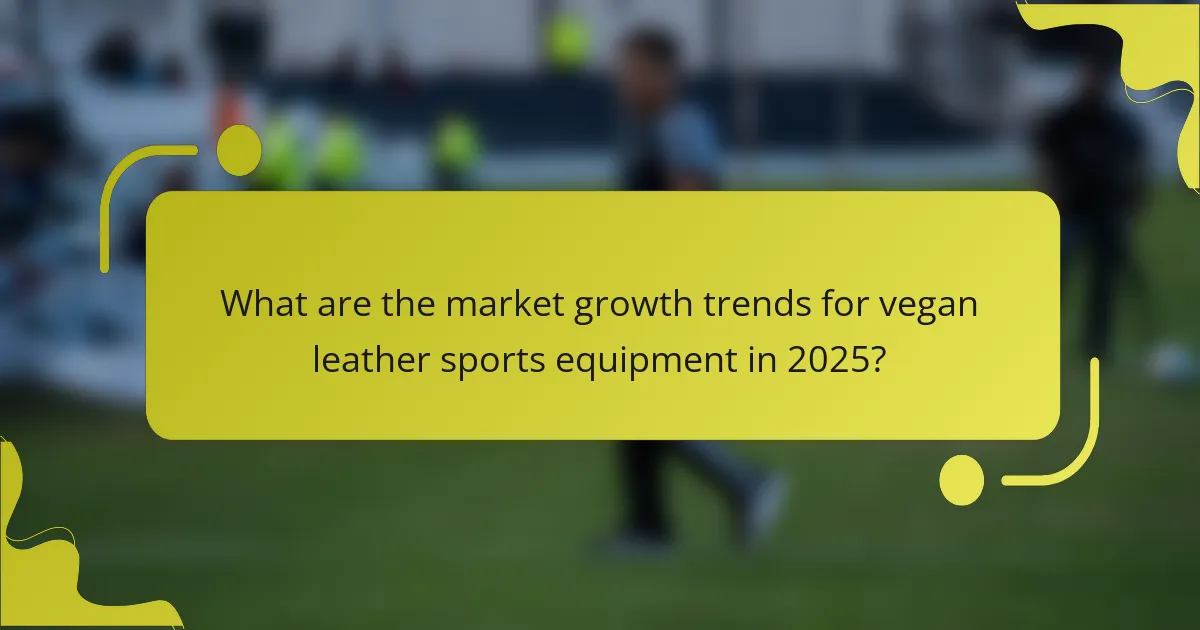
What are the market growth trends for vegan leather sports equipment in 2025?
The vegan leather sports equipment market is projected to grow significantly by 2025, driven by increasing consumer demand for sustainable alternatives. Factors such as ethical considerations, environmental awareness, and advancements in material technology contribute to this trend. The global market for vegan leather is expected to reach approximately $89 billion by 2025, with sports equipment comprising a notable segment. Companies focusing on high-performance attributes and eco-friendly production methods will likely lead this growth. As a result, the market will attract both established brands and new entrants aiming to capitalize on the sustainability movement.
Which demographic factors influence the growth of vegan leather in sports?
Demographic factors influencing the growth of vegan leather in sports include age, income, and lifestyle choices. Younger consumers prioritize sustainability, while higher income brackets are more willing to invest in premium eco-friendly products. Additionally, urban populations often exhibit a greater awareness of ethical consumption trends, driving demand for vegan leather sports equipment.
What challenges do manufacturers face in scaling vegan leather production?
Manufacturers face several challenges in scaling vegan leather production. Key issues include sourcing sustainable raw materials, maintaining consistent quality, and achieving cost competitiveness against traditional leather.
Sustainable sourcing often involves navigating complex supply chains and ensuring the materials are ethically produced. Quality consistency is essential for performance in sports equipment, as variations can affect durability and user experience.
Cost competitiveness remains a significant hurdle, as traditional leather often has established supply chains and lower production costs. As a result, manufacturers must innovate to reduce production costs while meeting ethical standards.
In summary, the main challenges are sustainable sourcing, quality consistency, and cost competitiveness.
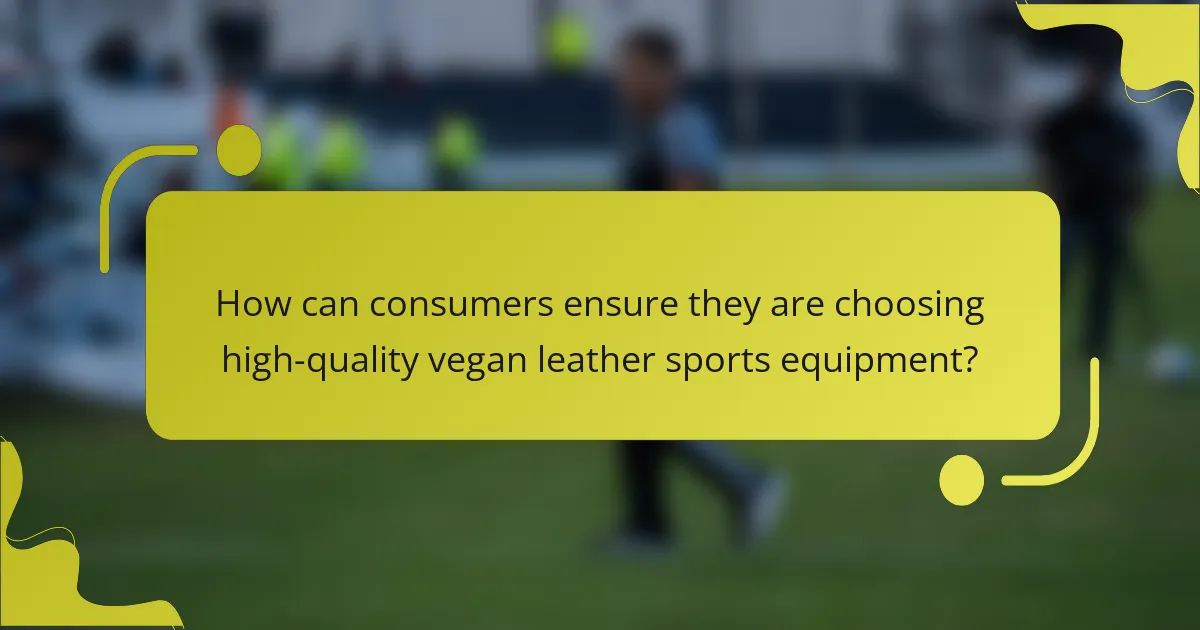
How can consumers ensure they are choosing high-quality vegan leather sports equipment?
Consumers can ensure they choose high-quality vegan leather sports equipment by assessing material durability, ethical sourcing, and brand reputation. Look for products made from plant-based materials like pineapple leather or mushroom leather, which offer sustainability and performance. Check certifications that guarantee eco-friendliness and fair labor practices. Research customer reviews and expert ratings to gauge performance and longevity. Finally, consider the warranty offered, as reputable brands often provide guarantees that reflect confidence in their product quality.
What common mistakes should consumers avoid when purchasing vegan leather gear?
Consumers should avoid several common mistakes when purchasing vegan leather gear. First, they should verify the material’s quality, as not all vegan leathers are created equal. Some products may use low-quality synthetic materials that do not perform well. Second, consumers should check for certifications that indicate ethical production practices, ensuring that the gear aligns with their values. Third, it’s essential to consider the environmental impact of the materials used, as some vegan leathers can still be harmful. Finally, consumers should compare prices and features across brands to avoid overpaying for subpar products.
Which certifications or labels indicate quality in vegan leather products?
Certifications and labels indicating quality in vegan leather products include PETA-Approved Vegan, Global Recycled Standard, and OEKO-TEX Standard 100. These certifications ensure ethical sourcing, environmental sustainability, and safety of materials used. PETA-Approved Vegan verifies that no animal products are involved. Global Recycled Standard confirms recycled content, while OEKO-TEX Standard 100 assesses harmful substances, promoting consumer trust in vegan leather sports equipment.
What expert tips can help consumers select the best vegan leather sports equipment?
To select the best vegan leather sports equipment, prioritize quality, sustainability, and performance. Look for reputable brands that use high-quality materials and adhere to ethical manufacturing practices. Consider the equipment’s durability, comfort, and how it meets your specific sports needs. Research customer reviews and product certifications to ensure you’re making an informed choice.
